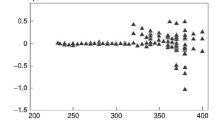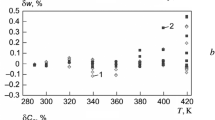Abstract
This study presents the experimental measurement of the \(p\rho T\) properties and critical parameters of a low GWP type refrigerant, trans-1,1,1,3-Tetrafluorobut-2-ene (HFO-1354mzy(E)). The sample purity of the substance was 99 area %. \(p \rho T\) property measurements and visual observations of the meniscus of HFO-1354mzy(E) were carried out using a metal-bellows volumometer with an optical cell. The critical temperature was determined by observation of the critical opalescence. The critical pressure and critical density were determined as the inflection point of the isothermal \(p \rho T\) property data at the critical temperature. For more precise clarification of the thermodynamic surface in the vicinity of the critical point, additional \(p \rho T\) property measurements were carried out on three isotherms in the supercritical region. The expanded uncertainties (\(k = 2\)) in the temperature, pressure, and density measurements were estimated to be less than 3 mK, 1.2 kPa, and 0.32 \(\hbox {kg} \cdot \hbox {m}^{-3}\), respectively. The expanded uncertainties of the critical parameters were estimated to be less than 13 mK, 1.4 kPa, and 2.3 \(\hbox {kg} \cdot \hbox {m}^{-3}\), respectively. These values are the first reported for HFO-1354mzy(E) and are necessary for the development of its equation of state in the near future.




Similar content being viewed by others
Abbreviations
- a:
-
Coefficient of the BWR type equation of the isotherm at the critical temperature, −
- p :
-
Pressure, MPa
- R:
-
Gas constant, \(\hbox {J} \cdot \hbox {K}^{-1} \cdot \hbox {mol}^{-1}\)
- T :
-
Temperature, K
- \(\rho \) :
-
Density, \(\hbox {kg} \cdot \hbox {m}^{-3}\)
- b:
-
Normal boiling point
- c:
-
Critical point
- est:
-
Estimation
- i :
-
The number of the term
- T :
-
Temperature
- \(\rho \) :
-
Density
References
Material Safety Data Sheet, 1300-3-46—(E)-1,1,1,3-Tetrafluoro-2-Butene (SynQuest Laboratories, Inc., Alachua, 2015)
E.W. Lemmon, M.L. Huber, M.O. McLinden, Reference fluid thermodynamic and transport properties (REFPROP), NIST Standard Reference Database 23, Version 9.1 (2013)
M. Sato, G. Masui, M. Uematsu, J. Chem. Thermodyn. 37, 931–934 (2005)
G. Masui, Y. Honda, M. Uematsu, J. Chem. Thermodyn. 38, 1711–1716 (2006)
Y. Honda, T. Sato, M. Uematsu, J. Chem. Thermodyn. 40, 208–211 (2008)
A. Sakabe, D. Arai, H. Miyamoto, M. Uematsu, J. Chem. Thermodyn. 40, 1527–1530 (2008)
W. Wagner, A. Pruss, J. Phys. Chem. Ref. Data 31, 387–535 (2002)
K.G. Jocack, R.C. Teid, Chem. Eng. Comm. 57, 233–243 (1987)
M. Benedict, G.B. Webb, L.C. Rubin, J. Chem. Phys. 8, 334–345 (1940)
L. Constantinou, R. Gani, AIChE J. Thermodyn. 40, 1697–1710 (1994)
J. Marrero, E. Pardillo, AIChE J. Thermodyn. 45, 615–621 (1999)
J.A. Beattie, D.G. Edwards, M. Stanley Jr., J. Chem. Phys. 17, 576 (1949)
J.F. Connolly, J. Phys. Chem. 66, 1082–1086 (1962)
R. D. Goodwin, W. M. Haynes, NBS Tech. Note 1052, Boulder, (1982)
J.M. Levelt Sengers, H.B. Kamgar-Parsi, J.V. Sengeres, J. Chem. Eng. Data 28, 354 (1983)
Acknowledgements
The present research was partly supported by the Thermal Management Materials and Technology Research Association (TherMAT) program, New Energy and Industrial Technology Development Organization (NEDO), and Waseda Research Institute for Science and Engineering, Japan.
Author information
Authors and Affiliations
Corresponding author
Appendix
Appendix
Measurements were carried out on isobutane (99.99 mol % purity, Takachiho Chemical Industrial Co., Ltd., Ibaraki, Japan) as a test to confirm the reliability of the measurement procedure. Figure 5 shows the observation results of the critical phenomena and the critical opalescence. The critical temperature was determined to be 407.69 K, at which the strongest critical opalescence was observed.
Isotherm for isobutane at the critical temperature (407.69 K) and the fitted line: \(\circ \), present data; –, calculated values from Eq, (1); +, the determined critical point
Critical point for isobutane on \(T{-}\rho \) plane and \(p{-}\rho \) plane:

Next, we performed a series of additional \(p \rho T\) property measurements at the determined critical temperature to determine the critical density and critical pressure. The obtained isothermal \(p \rho T\) property data at the critical temperature were fitted to the simplified BWR equation. The results of the fitting for isobutane are shown in Fig. 6. Fitting of the simplified BWR equation to the experimental data yielded the critical parameters of \(p_{c} = 3.635\) MPa, and \(\rho _{\mathrm{c}} = 223.1\,\hbox {kg}\cdot \hbox {m}^{-3}\) by observing the slope and curvature of this equation as mentioned above. The critical parameters thus determined are summarized in Table 2 with other published values for isobutane. These data are illustrated on \(T-\rho \) plane and \(p-\rho \) plane in Fig. 7. Reasonable agreement between our values and those previously published was confirmed, indicating that the present measurement method was suitably reliable.
Rights and permissions
About this article
Cite this article
Kimura, T., Kayukawa, Y., Miyamoto, H. et al. Critical Parameters and Critical-Region (\(p,\rho ,T)\) Data of trans-1,1,1,3-Tetrafluorobut-2-ene [HFO-1354mzy(E)]. Int J Thermophys 38, 122 (2017). https://doi.org/10.1007/s10765-017-2256-0
Received:
Accepted:
Published:
DOI: https://doi.org/10.1007/s10765-017-2256-0







